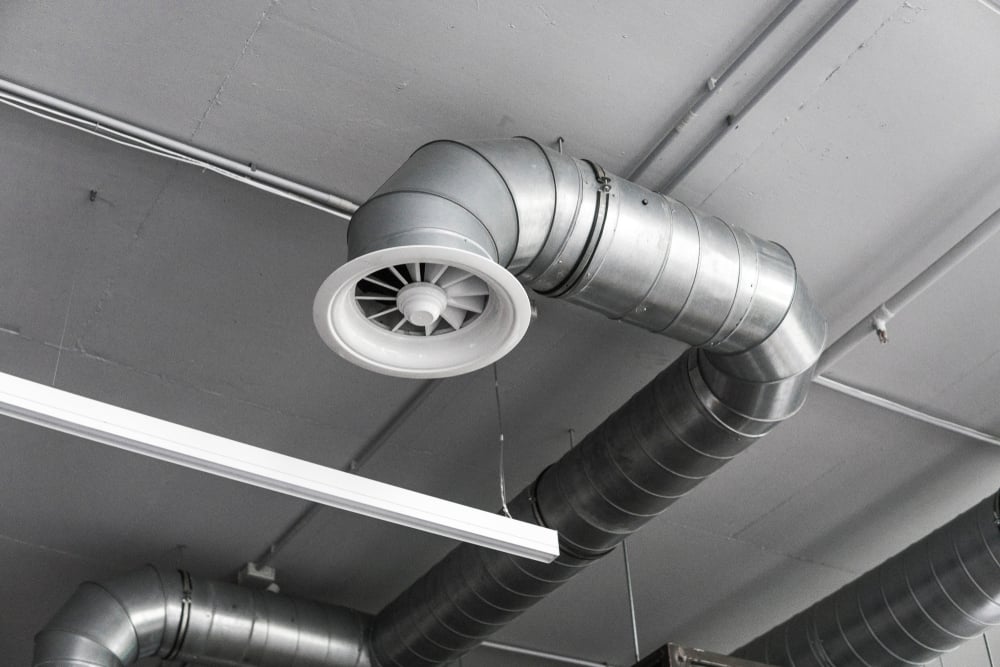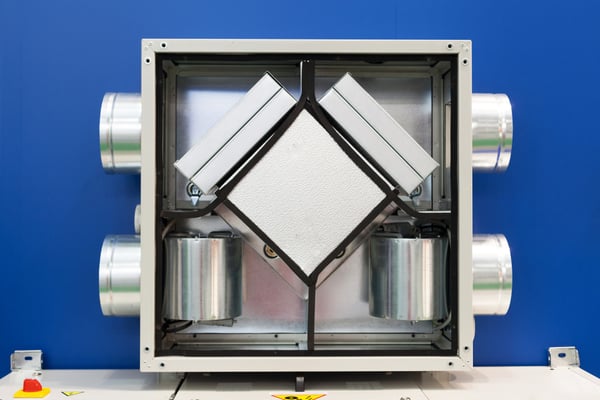Understanding Ventilation Efficiency Measures: DCV, ERV and Airside Economizers

Air handlers and other ventilation devices have a much lower energy consumption than heating and cooling equipment. However, the operating conditions of a ventilation system have a significant impact on air conditioning and space heating loads. As a result, ventilation efficiency measures can improve the overall performance of an HVAC installation.
The air in most buildings is 2 to 5 times more polluted than outdoor air, according to the US Environmental Protection Agency. Indoor air quality improves when a ventilation system increases the outdoor air supply, except at times when outdoor air is very polluted. However, a higher ventilation rate also means there is more air to cool or heat, depending on the time of the season. Energy efficiency measures for ventilation systems should optimize power consumption, but without compromising air quality.
The following are some common ventilation measures that improve HVAC efficiency. They can be used together in a project, but understanding their interaction is important:
- Demand controlled ventilation (DCV)
- Energy recovery ventilation (ERV)
- Airside economizer
Reduce your heating, cooling and ventilation costs.
Demand Controlled Ventilation
DCV consists on reducing the ventilation rate according to occupancy. This not only reduces the energy consumption of fans, but also the energy needed to condition the outdoor air supply. For example, if outdoor air is being cooled by 10°F and airflow is reduced from 1,000 cfm to 500 cfm, the cooling input required is reduced by around 50%.
The main drawback of DCV is that air pollutants can reach a higher concentration when outdoor airflow is reduced. ASHRAE standards provide a simple solution: establishing a lower limit for the outdoor air supply, and configuring the DCV system to never drop below that value.
DCV systems are normally controlled with carbon dioxide sensors, since occupancy can be correlated with the CO2 concentration in the air. However, the system can be enhanced with sensors to detect air pollutants directly. This way, the airflow can respond to air pollutants like particulate matter and volatile organic compounds. There is some correlation between occupancy and air pollution, but some sources are independent from the number of people. For example, recently painted walls and new furniture both release VOCs.
Energy Recovery Ventilation

Energy recovery ventilation consists on exchanging heat and humidity between the outdoor air supply and the exhaust air. There are many ways in which this concept saves energy:
- During winter, when the building interior is warmer, the exhaust air can preheat the outdoor air supply with a heat exchanger. This reduces the space heating load.
- The opposite process applies during summer, since indoor air can precool the outdoor air. This reduces the air conditioning load.
- The system can also exchange moisture to reduce humidification or dehumidification loads. This applies when the outdoor air is very dry or very humid.
When an ERV system only exchanges heat, it is described as heat recovery ventilation (HRV). When there is also humidity exchange, a more accurate term is enthalpy recovery ventilation.
ERV and DCV can operate together without interfering. The DCV system determines the outdoor air supply, while the ERV system reduces the heating or cooling load caused by that airflow.
Airside Economizer
Heat sources in buildings can be internal or external. Indoor heat is normally released by occupants, appliances and equipment. On the other hand, the main sources of outdoor heat are direct sunshine and warm air. Under some conditions, the outdoor air is cool enough to compensate for indoor heat sources, and suitable temperatures can be reached with ventilation alone. An airside economizer increases the outdoor air supply in these cases.
Economizers are unsuitable for warm and humid climates, since the opportunities for free cooling with outdoor air are very rare. However, they can achieve significant air conditioning savings when the weather is adequate.
Unlike ERV systems, which operate independently from DCV, economizer are in competition with DCV. While a DCV system will try to reduce the outdoor air supply in response to occupancy, the economizer will try to increase it to save on air conditioning. When DCV and an economizer are deployed together, the control system must be smart enough to detect which of the two savings is greater.
- When the air conditioning savings from the economizer surpass the potential savings from reduced airflow, the economizer should override the DCV system.
- On the other hand, the DCV system should have priority when the savings opportunity with reduced airflow is higher.
An ERV system and an economizer do not interfere because they are mutually exclusive. When there is an opportunity to use the economizer, the outdoor air is cooler than indoor air. In other words, the indoor air cannot be used for precooling, and the ERV system is inactive.
Conclusion
DCV, ERV and an airside economizer can all contribute to HVAC efficiency. However, the effectiveness of each measure varies depending on building conditions and the local weather. To identify the most suitable energy efficiency measures, the best recommendation is getting in touch with a professional HVAC engineering firm.
DCV and ERV can normally operate together without trouble, and can achieve synergy. On the other hand, DCV and an airside economizer are in opposition, and a control system must give priority to the greater benefit. Finally, an economizer and an ERV system - when the outdoor air is cool enough for the economizer, precooling with indoor air is not possible.

Anuj Srivastava
Anuj Srivastava is a principal partner at NY Engineers. He is known for his MEP franchise market knowledge. Anuj is currently leading a team of 100+ MEP/FP engineers and has successfully led over 1500 franchise projects in the US.
Join 15,000+ Fellow Architects and Contractors
Get expert engineering tips straight to your inbox. Subscribe to the NY Engineers Blog below.



